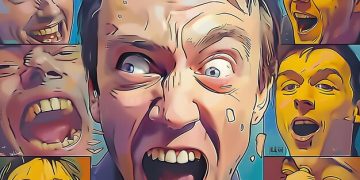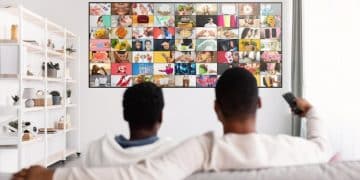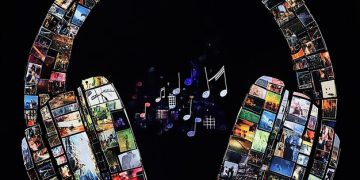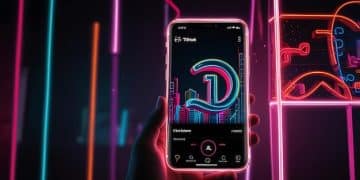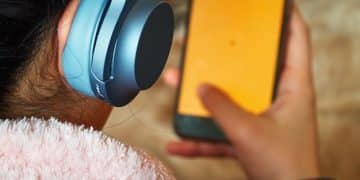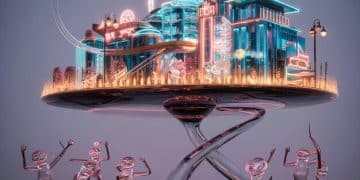How AI is Creating New Music and Art in Pop Culture
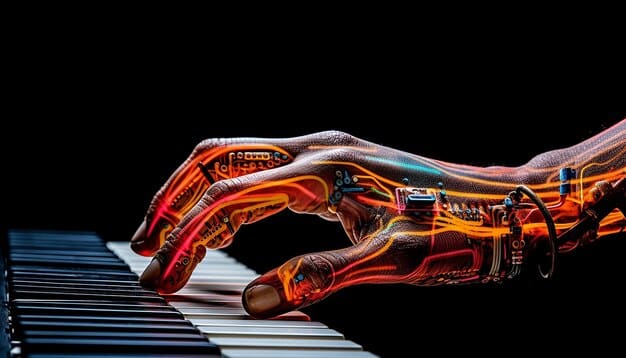
Artificial intelligence is revolutionizing pop culture by becoming a dynamic tool for creating novel music, visual art, and interactive experiences, pushing creative boundaries and influencing artistic expression across various media.
In an era defined by rapid technological advancement, the intersection of artificial intelligence and creative expression is reshaping the very fabric of pop culture. The question of How AI is Being Used to Create New Music and Art in the Pop Culture Landscape is no longer theoretical but a tangible reality, with algorithms actively contributing to the sounds we hear and the images we see. From generating chart-topping melodies to designing immersive visual experiences, AI is emerging as an indispensable collaborator, challenging traditional notions of authorship and innovation.
The Dawn of Algorithmic Composition
The idea of machines creating music once seemed like science fiction, yet today, AI-powered software is composing intricate pieces that blur the lines between human and synthetic creation. These systems analyze vast datasets of existing music—from classical symphonies to contemporary pop hits—to learn patterns, harmonies, and rhythmic structures. This data-driven approach allows AI to generate original compositions, explore new genres, and even mimic the styles of renowned artists. The implications for the music industry are profound, offering new avenues for creativity and mass production.
One of the most compelling aspects of AI in music is its ability to accelerate the creative process. Composers and producers can use AI tools to quickly prototype ideas, generate variations of melodies, or even fill in missing instrumental parts. This speeds up production cycles, making music creation more accessible and efficient. It also opens doors for new collaborations, where human ingenuity and AI capabilities merge to produce something unique.
AI as a Creative Partner for Musicians
For many artists, AI isn’t replacing human talent but enhancing it. Musicians are leveraging AI tools to overcome creative blocks, experiment with new sounds, and refine their artistic vision.
- 🎶 Melody Generation: AI can propose new melodic lines and harmonic progressions, giving artists fresh starting points.
- 🎧 Beat Production: Algorithms are used to create complex drum patterns and basslines, often beyond human capacity for spontaneous variation.
- 🎤 Vocal Synthesis: AI can generate realistic singing voices, allowing for vocal experimentation without the need for human vocalists in early stages.
- 🎛️ Mixing and Mastering: AI-powered tools assist in professional audio production, optimizing sound quality and balance.
The technology also enables customizable music experiences. Imagine a video game where the soundtrack dynamically adapts to player actions, or a fitness app whose music matches your workout intensity. AI can facilitate these dynamic, personalized audio landscapes, making interactions more immersive and engaging. This level of adaptability represents a significant leap forward from static, pre-recorded soundtracks. The continuous evolution of AI in musical composition promises an exciting future where soundscapes are as fluid and diverse as the world around us.
Generative Art: Visuals Beyond Imagination
Just as AI is transforming music, it is also making colossal strides in the realm of visual arts. Generative adversarial networks (GANs) and other deep learning models are capable of creating stunning, original artworks, from photorealistic portraits to abstract landscapes. This new form of digital art challenges traditional artistic definitions and opens up a vibrant space for exploration within pop culture. The ability of AI to learn from millions of images allows it to understand composition, color theory, and artistic styles, then apply that knowledge to create unique pieces.
The accessibility of AI art tools has democratized creation, allowing individuals without formal artistic training to produce sophisticated visuals. This has led to an explosion of AI-generated content across social media platforms, transforming how art is consumed and perceived. Brands are also quick to adopting AI art for advertising campaigns, product design, and immersive digital experiences. The visual identity of pop culture is rapidly evolving under the influence of these algorithms.
Transforming Visual Narratives and Design
AI’s influence extends beyond standalone artworks, impacting the entire spectrum of visual narratives. It’s being used in film production, animation, and even fashion design.
- 🖼️ Concept Art: AI rapidly generates diverse concept art for films and games, helping visualize scenes and characters.
- 🖌️ Style Transfer: Algorithms can apply the artistic style of one image onto another, creating unique visual effects.
- 👕 Fashion Design: AI assists in generating new textile patterns, garment designs, and even predicting fashion trends.
One fascinating application is in the creation of non-fungible tokens (NFTs), where AI-generated art is gaining significant traction. Artists are using AI to produce series of unique digital collectibles, pushing the boundaries of what constitutes valuable art in the digital age. This synergy between AI and blockchain technology has created a new economy around digital art, captivating collectors and further solidifying AI’s role in contemporary art markets. The visual quality and complexity of AI-generated art are continually improving, signalling a future where machine-created aesthetics are commonplace and celebrated.
The Rise of AI in Entertainment Production
Beyond individual artistic creations, AI is increasingly integrated into the broader entertainment production pipeline. From scriptwriting to animation and special effects, AI tools are streamlining processes, reducing costs, and opening new avenues for narrative and visual storytelling. This technological shift is observable across various media, including film, television, and video games, fundamentally altering how content is conceived and delivered to audiences. The creative industry benefits from AI’s capacity to handle repetitive tasks, freeing human artists to focus on higher-level creative decisions and innovation.
AI can analyze massive amounts of data, including audience preferences, box office success, and narrative structures, to inform creative decisions. This data-driven approach can help producers identify emerging trends, predict audience reception, and even suggest optimal casting choices. While this raises questions about artistic authenticity, it undoubtedly provides powerful insights that can lead to more commercially successful and audience-engaging content.
Revolutionizing Storytelling and Audience Engagement
AI’s impact on entertainment productions is multi-faceted, ranging from enhancing storytelling to personalizing audience experiences.
- 🎥 Script Analysis: AI can analyze scripts for pacing, character development, and genre consistency.
- 🎨 Animation Assistance: Algorithms help automate tedious animation tasks such as in-betweening frames and character rigging.
- ⚡ Special Effects: AI enhances visual effects by generating realistic environments, explosions, or creature movements.
- 🎮 Game Design: AI assists in procedural content generation for video games, creating vast and dynamic worlds.
The burgeoning field of interactive entertainment, particularly video games, is a prime example of AI’s transformative power. AI not only powers complex non-player characters (NPCs) with realistic behaviors but also contributes to procedural content generation, allowing for infinite variations of game worlds, quests, and scenarios. This ensures a continually fresh and engaging experience for players, moving beyond the fixed narratives of traditional media. As AI continues to evolve, its role in shaping immersive and personalized entertainment will only grow, paving the way for truly dynamic and responsive media landscapes.
Ethical and Creative Dilemmas
The rapid integration of AI into creative fields naturally raises a host of ethical and creative dilemmas. Questions of authorship, intellectual property, bias in algorithms, and the impact on human artists are at the forefront of discussions. As AI generates more sophisticated and human-like creations, defining who owns the copyright—the programmer, the user, or the AI itself—becomes complex. These are fundamental issues that need to be addressed as the technology proliferates.
Another significant concern is the potential for AI to replicate and amplify existing biases present in its training data. If an AI is trained on datasets reflecting societal inequalities, its outputs may inadvertently perpetuate or even exacerbate those biases, leading to a lack of diversity in art and music. Ensuring fairness and representation in AI models is crucial to fostering an inclusive creative landscape. Furthermore, the very definition of “art” is being questioned: can a machine truly be an artist, or is it merely a tool?
Navigating the Future of Art and Authorship
Addressing these dilemmas requires a multi-faceted approach involving legal frameworks, ethical guidelines, and societal discourse.
- ⚖️ Copyright Challenges: Establishing clear guidelines for copyright ownership of AI-generated content.
- 🤝 Bias in Data: Developing methods to identify and mitigate biases in training datasets for AI artistic models.
- 🤖 Authenticity Debate: Re-evaluating the philosophical definition of art and creativity in an age of machine creation.
The economic impact on human artists is another relevant point. While AI tools can enhance productivity, there is a legitimate concern that they might devalue human creative labor or reduce demand for certain artistic skills. Striking a balance where AI augments rather than displaces human creativity is essential for the long-term health of the creative industries. Encouraging collaboration between human artists and AI, fostering education about AI tools, and exploring new business models can help mitigate potential negative impacts. The ongoing dialogue around these issues will shape the future trajectory of AI in art and pop culture.
AI’s Role in Personalization and Consumption
Beyond creation, AI is profoundly influencing how audiences discover and consume music and art. Recommendation algorithms, powered by AI, have become ubiquitous, forming the backbone of streaming platforms like Spotify, Apple Music, Netflix, and TikTok. These algorithms analyze user preferences, listening habits, and viewing histories to curate highly personalized content feeds, ensuring that individuals are constantly exposed to content tailored to their tastes. This has redefined the idea of discovery, moving from traditional curation by critics or labels to an individualized, algorithm-driven experience.
This personalization extends to dynamic content delivery, where AI can modify aspects of content in real-time to better suit an individual or a specific context. Imagine a piece of music that changes its tempo or instrumentation based on your mood, or an art piece that subtly alters its colors to match the ambient lighting of a room. This level of adaptive content offers unprecedented opportunities for immersive and engaging user experiences, making art and music more responsive than ever before.
Curating Experiences and Building Communities
AI’s influence in consumption isn’t limited to individual experiences; it also has a hand in shaping communities and trends.
- 📈 Trend Prediction: AI analyzes vast data to predict emerging trends in music, art, and fashion.
- 💬 Fan Engagement: AI chatbots and analytics help artists better understand and engage with their fan bases.
- Discovering niche content by connecting users with obscure artists or genres they might otherwise never encounter.
The data collected by AI on consumption patterns provides invaluable insights for artists, marketers, and researchers. Understanding what resonates with different demographics can inform future creative endeavors and marketing strategies. This feedback loop between creation, consumption, and analysis, largely powered by AI, creates a dynamic ecosystem where art and pop culture evolve rapidly, driven by both algorithmic insights and human preference. The future of media consumption is unequivocally personalized, dynamic, and largely orchestrated by intelligent algorithms.
The Future Landscape: Human-AI Synergy
Looking ahead, the trajectory of AI in pop culture points towards a deeper, more integrated collaboration between human creativity and artificial intelligence. Rather than AI completely taking over artistic domains, the most impactful future will likely involve a synergy where humans continue to be the primary visionaries and emotional core, while AI serves as an immensely powerful tool for execution, exploration, and augmentation. This partnership could unlock unprecedented levels of creativity and efficiency, leading to forms of art and music that are currently unimaginable.
The evolution will also likely see AI becoming more intuitive and user-friendly, allowing a broader range of creators—from hobbyists to seasoned professionals—to leverage its capabilities without needing extensive technical knowledge. This democratization of advanced creative tools will foster an environment ripe for experimentation and innovation, leading to a richer and more diverse pop culture landscape. The narrative will shift from “AI vs. Human” to “Human-AI collaboration.”
Evolving Artistic Roles and New Cultural Forms
This synergy will redefine traditional artistic roles and potentially give rise to entirely new cultural forms.
- 💡 Hybrid Artists: Emergence of artists who specialize in directing AI models to achieve specific artistic visions.
- 🌐 Immersive Experiences: Creation of highly interactive, AI-driven immersive art installations and musical performances.
- 🔀 Cross-media Innovation: AI facilitating seamless integration of music, visuals, and narrative across different media platforms.
The legal and ethical frameworks will also need to mature to keep pace with technological advancements, ensuring that the benefits of AI art are broadly distributed and potential harms are mitigated. Debates around intellectual property, fair compensation for human artists, and the responsible deployment of AI will continue to shape policy and industry standards. Ultimately, the future of AI in pop culture is not merely about algorithmic prowess but about how humanity chooses to wield this power to expand our collective creative potential and enrich our cultural experiences. This exciting frontier promises a future where artistic expression is unbounded by traditional limitations.

| Key Aspect | Brief Description |
|---|---|
| 🎵 Music Creation | AI generates melodies, harmonies, and orchestrations, enhancing human composition processes. |
| 🎨 Visual Art Generation | AI creates novel images and visual styles for various artistic and commercial applications. |
| 🎬 Entertainment Production | AI streamlines film, game, and animation production, from script analysis to special effects. |
| 💡 Ethical Discussions | Ongoing debates about AI authorship, copyright, and potential biases in algorithmic art. |
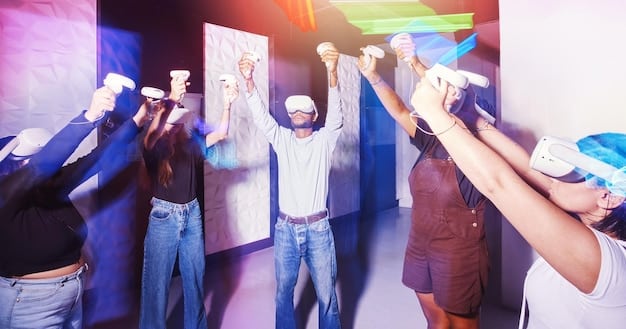
Frequently asked questions
Yes, AI can generate music that is virtually indistinguishable from human compositions, particularly in genres with strong structural patterns. Advanced AI models have learned complex musical theories and emotional nuances, allowing them to produce tracks that resonate deeply with human listeners and even evoke specific feelings effectively.
AI is used in visual art for generating original artworks, style transfer (applying one image’s style to another), creating hyper-realistic images, and designing concepts for various media. It also helps in automating aspects of animation and creating unique digital collectibles, pushing the boundaries of traditional artistic mediums significantly.
While AI can automate some tasks, it is generally seen as a tool to augment human creativity rather than replace it entirely. Many artists are now leveraging AI to enhance their workflow, explore new creative avenues, and increase efficiency, transforming the artistic landscape into a collaborative human-AI environment that fosters innovation and new forms of expression.
AI personalizes content by analyzing user data, preferences, and consumption patterns to recommend tailored music, videos, and art. This allows streaming platforms to curate highly individualized experiences, ensuring users discover content aligned with their tastes. The result is a more engaging and relevant media consumption pattern for each individual.
The copyright implications are complex and rapidly evolving. Current laws often struggle to define ownership for AI-generated works, raising questions about whether intellectual property belongs to the AI’s programmer, the user of the AI, or if AI can even hold rights. Legal frameworks are being developed to address these novel challenges in the creative domain.
Conclusion
The integration of AI into music and art represents a monumental shift in pop culture, moving beyond mere tools to sophisticated collaborators in the creative process. From algorithmic compositions that challenge our understanding of melody to generative art pushing visual boundaries, AI is not just mimicking human creativity but expanding it in unprecedented ways. While ethical and economic considerations remain paramount, the undeniable synergy between human ingenuity and artificial intelligence promises a future where artistic expression is more diverse, personalized, and dynamically engaging than ever before. This evolving landscape compels us to rethink traditional definitions of art, artist, and audience, inviting us into a new era where the possibilities are virtually limitless.
